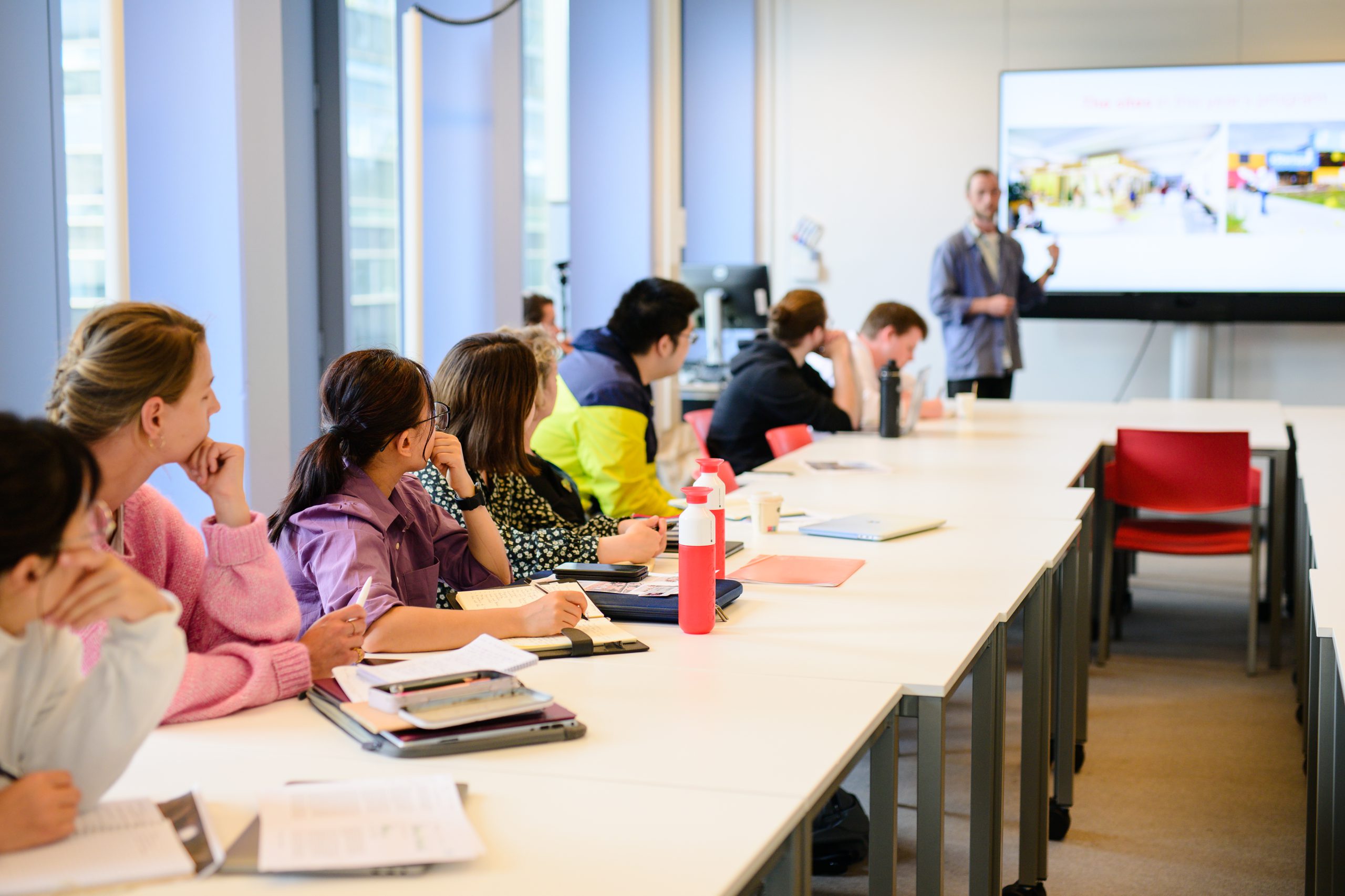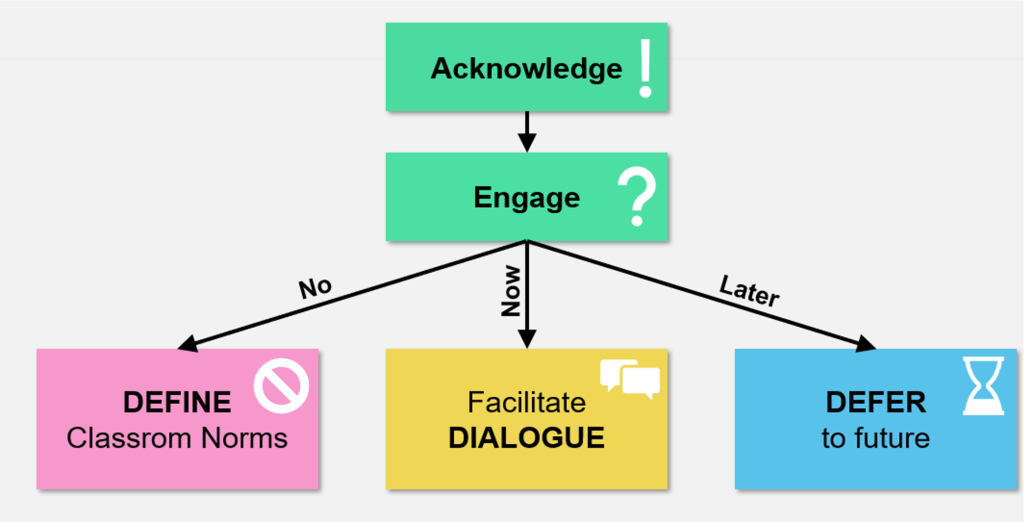
Hot Moments: navigating difficult moments in the classroom
Can students say what they want during tutorials, even if it hurts someone else – and how do you, as a teacher, deal with that? How do you ensure that discussions in class can be conducted freely and with mutual respect?
Increasingly, teachers and students encounter uncomfortable or unsafe situations during class where one person’s opinion clashes with another’s integrity. In such heated, offensive, tense (HOT) moments, the class can derail, and as a teacher, you can quickly find yourself at a loss for words: at such a moment, “people’s emotions – often conflicting – can escalate to a point where education is compromised. This can occur during discussions on topics people are personally invested in, or as a result of class dynamics in any discipline” (Warren 2006). Moreover, poorly discussed topics can further polarize a group, causing more harm than good. However, confrontation and discussion are crucial in science and education, and precisely for that reason, HOT moments can be seen as enriching learning opportunities: in a more confrontational didactic way, dialogue can broaden awareness. It is therefore crucial that a discussion on sensitive topics is consciously facilitated in a respectful and inclusive dialogue, creating space for different and even opposing perspectives.
Safe learning environment
In many disciplines, topics are often studied that are directly related to the diverse identities of our students, and precisely for that reason, hurtful remarks during class discussions can jeopardize social safety. Additionally, students’ personal input is often seen as essential for critical thinking, a frequently pursued learning objective in our education. However, not everyone is or feels equally free to speak, and some viewpoints hurt others: instead of an egalitarian safe space, the classroom is also a reflection of societal inequalities (Harlap, 2013). It is the responsibility of the teacher to provide a safe learning environment where there is room for divergent and opposing viewpoints, and where intellectual discomfort is seen as part of a valuable learning moment.
Tips for dealing with HOT moments
Clashing opinions, cultural differences, prejudices and exclusion, silenced viewpoints, or uncomfortable actions (Ramdas, Slootman, & Van Oudenhoven-Van Der Zee, 2019): these are common circumstances for HOT moments in education. Below are some tips for dealing with HOT moments and maintaining a safe learning environment (Warren, 2006).
Students can express themselves better when you, as a teacher, have control over the situation. Take the time to regroup yourself as well: students often mimic the attitude of a teacher and can also take a break and catch their breath in turn.
From the outset, make clear agreements with your students about how discussions will be conducted, or if necessary, establish them at the moment. Try to involve your students in this process. Above all, do not tolerate personal attacks, and establish agreements that facilitate an open discussion: be open to diverse viewpoints and ask students to clearly argue their point. Set clear boundaries: if necessary, refer to the UvA code of conduct, and make it clear that there is no room for racist, sexist, or oppressive views and deliberate insults; avoid generalizations.
Establishing clear agreements also provides clarity regarding topics that are not up for discussion: remarks and behaviors that are unacceptable according to the code of conduct certainly do not require extensive discussion. Naming and by doing so, acknowledging, the issue within the learning environment and a referral (to your own office hours/moment after class, and/or if necessary to the social safety advisor) suffices in this case. When the topic lends itself to a fruitful discussion, a teacher may also choose to postpone the discussion to a later time. In that case, emphasize the importance of the topic and of a more extensive discussion of it: this way, students feel that difficult topics are open for discussion, and that certain viewpoints and sensitivities do not go unnoticed.
Even when a comment seems like a personal attack, it’s usually not directed against you as a person but rather against you as an authority figure – the teacher. By keeping this distinction between the personal and professional in mind, you can better understand the position of a student: students often speak from their specific socioeconomic position or personal experience, so there’s often a broader issue behind an opinion. Ask yourself, “what is the subtext of this opinion? What is the student really saying, why does it matter, and why now specifically?”
Know your own biases, sensitivities, and pet peeves. Through active self-reflection, as a teacher, you’ll be less likely to be caught off guard: self-awareness is a good preparation for the unexpected, as you can also tailor your own reactions and strategies to it.
Take the point out of the student’s hands and broaden the discussion to a more general level. For example: “Many people share this opinion. Why is that, what are their reasons?” or “Why do people who disagree have a different opinion about this?” This way, you protect the student in question while encouraging others who disagree to engage in the discussion and express their viewpoints.
You can even incorporate this as an active component in the lesson. Ask students to listen to the opposing viewpoint, ask questions, and then repeat and support the viewpoint. This exercise can turn the most difficult moments into interesting learning opportunities.
Ask students to write about the incident, during or after the lesson. This can provide a moment of calm and reflection before opening the discussion on the topic. You can ask them to inquire the subject and request a more elaborate essay, develop an assignment around taking opposing viewpoints or just ask for an informal, written reflection before revisiting the topic.
Sometimes it may be necessary to speak to students after class, especially those who have been at the center of such a hot moment. This can help them see this experience as enriching – enriching about themselves, others, alternative viewpoints, the subject in general, and about how they can express their opinions and be heard, even by those who disagree. These conversations can ensure that students do not feel targeted and continue to come to class with an open mindset and eagerness to learn.
 |
Under the influence of (social) media, and due to possible direct involvement with students, current events can also lead to heightened tensions in the lecture hall. It’s important for students to experience that what they discuss in class is directly related to the world outside the university. Therefore, discussions around sensitive, current topics are often indispensable in a student’s education. To facilitate constructive discussion in a safe manner you can keep the following recommendations in mind:
- Distinguish between facts and opinions: Ensure that you are well-informed and base your discussions on facts, official positions of (inter)national governments, and human rights organizations. Facts can provide a clear framework for situating opinions and feelings about current developments. Provide additional explanation where necessary regarding (social) media and misinformation.
- Consult with colleagues: Discuss within your team how you will handle discussions about sensitive events. Not only can you share valuable advice and tips with each other, but it’s also important to be aware of what is or isn’t happening among students.
- Don’t condemn students for their opinions, inquire further: By actively listening, you enable a broader discussion in which students can find common ground despite differences of opinion.
- Better not to discuss than to discuss poorly: You may prefer not to facilitate a certain discussion, or at least postpone it. If you assess that emotions are running so high that social safety is compromised, make it clear that the discussion cannot be safely conducted at that moment and postpone it to a later time. However, do not avoid the topic altogether, but rather address the necessity (and absence) of a safe learning environment to discuss it constructively. You can also ask students to prepare for a follow-up discussion at home.
The way in which you can transform HOT moments into learning opportunities as a teacher is very intuitive and requires an inclusive attitude and self-reflection. Therefore, it’s certainly not an easy task: when you really don’t know what to do, at least mention the importance of the topic and that the discussion will take place at a later time. This way, you and your students can prepare, and students know that the conflict and the topic are being taken seriously.
Sources and useful links
- Do’s and don’ts. Ter-info.net, Universiteit Utrecht (2023).
- Harlap, Y. (2013). Preparing university educators for hot moments: Theater for educational development about difference, power, and privilege. Teaching in Higher Education, 19(3), 217-228.
- Ramdas, S., Slootman, M., & Van Oudenhoven-Van Der Zee, K. (2019). The VUMixed Classroom Educational Model. Amsterdam: Vrije Universiteit Amsterdam.
- Warren, L. (2006). Managing Hot Moments in the Classroom. Cambridge, MA: Derek Bok Center for Teaching and Learning.






